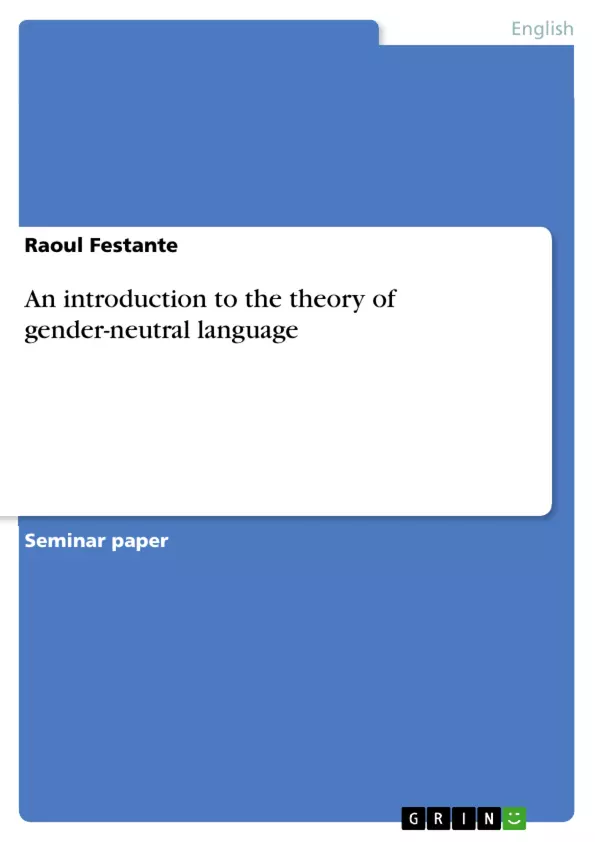In the following paper I will deal with the concept of gender-neutral language. I will begin by looking at certain false generics that are commonly used in English Language and consider the position of gender-neutral language theorists to these false generics. Due to the fact, that the gender-neutral language theory offers very general recommendations and guidelines i felt difficult to do a corpus analysis. That is why I tried to concentrate only on the main positions of gender-neutral language theory and focus on central issues within he scope of this approach.
I concentrate on two particular false generics that are at the focus of gender -neutral language theory; “Man” as a generic form used in the English language to define male and female and the ambiguous use of the pronoun “He” in contexts where both sexes are to be addressed. In the second and third chapter I will take a closer look at these false generics and exemplify how they create misunderstanding and actually promote a male centred perception. In the fourth chapter I will deal with the guidelines and recommendations of language planners and gender-neutral language theorists and work out their main positions. It will be argued, that language change is not an easy undertaking but requires perseverance and consistent argumentation. The biggest challenge for language planners who want to implement genderneutral language is perhaps the persistent resistance towards the understanding, that gender - neutral language is not an issue concerning only feminists.
I will conclude by evaluating the gender-neutral language theory in terms of its practicability and give a personal opinion on the approach.
Table of Contents
- Introduction
- What is gender-neutral language?
- historical background
- "Man"
- Generic "he"
- False generics: “Man” & “He
- The generic "Man"
- "Man" in gendered compounds
- The generic "He"
- Recommendations for alternative forms
- Guidelines for replacing the generic "He"
- Guidelines for replacing the generic “Man”
- Conclusion
- Bibliography
Objectives and Key Themes
This paper examines the concept of gender-neutral language in the English language, specifically focusing on the use of "Man" as a generic term and the ambiguous use of the pronoun "He" when referring to both sexes. The paper explores how these false generics perpetuate a male-centered perspective and hinder gender-inclusive language. It analyzes the recommendations and guidelines proposed by gender-neutral language theorists for addressing these issues and highlights the importance of language change in promoting a more equitable and inclusive society.
- Analyzing the historical development of gender-neutral language in English
- Exploring the problematic use of "Man" as a generic term and its implications for gender equality
- Investigating the ambiguous use of the pronoun "He" and its contribution to gender bias
- Examining the recommendations and guidelines for achieving gender-neutral language
- Discussing the challenges and potential benefits of implementing gender-neutral language practices
Chapter Summaries
- Introduction: This chapter introduces the topic of gender-neutral language and outlines the paper's focus on analyzing two common false generics: "Man" and "He." It explains the difficulty of conducting a corpus analysis due to the general nature of gender-neutral language theory and highlights the paper's focus on the main positions within this approach.
- What is gender-neutral language?: This chapter defines gender-neutral language and its historical context, focusing on the problematic use of "Man" as a generic term and the ambiguous use of the pronoun "He." It highlights how these elements often support a male-dominated perception of language and hinder gender-inclusive communication. The chapter discusses examples of words and phrases like "mankind," "salesman," and "average working man" to illustrate this issue.
- 2.1.1 "Man": This chapter delves deeper into the historical use of "Man" in the English language, tracing its evolution from a term encompassing both sexes to its current use as a primarily male-identifying term. It examines how the original inclusive meaning of "Man" has been replaced by a more exclusive interpretation, leading to potential misinterpretations and undermining gender-inclusive language.
- 2.1.2 The generic "He": This chapter explores the use of pronouns like "He," "His," and "Him" to refer to individuals of either sex. It highlights how this practice can lead to misunderstanding and create a gender bias by perpetuating a male-centric perspective. Examples are provided to illustrate how these pronoun choices can lead to an uneven representation of genders in language.
Keywords
The main keywords and focus topics of this text include gender-neutral language, false generics, inclusive language, gender bias, "Man" as a generic term, pronoun usage, "He" as a generic pronoun, language change, gender-inclusive communication, and the historical development of English language.
- Arbeit zitieren
- Raoul Festante (Autor:in), 2004, An introduction to the theory of gender-neutral language, München, GRIN Verlag, https://www.grin.com/document/42742



